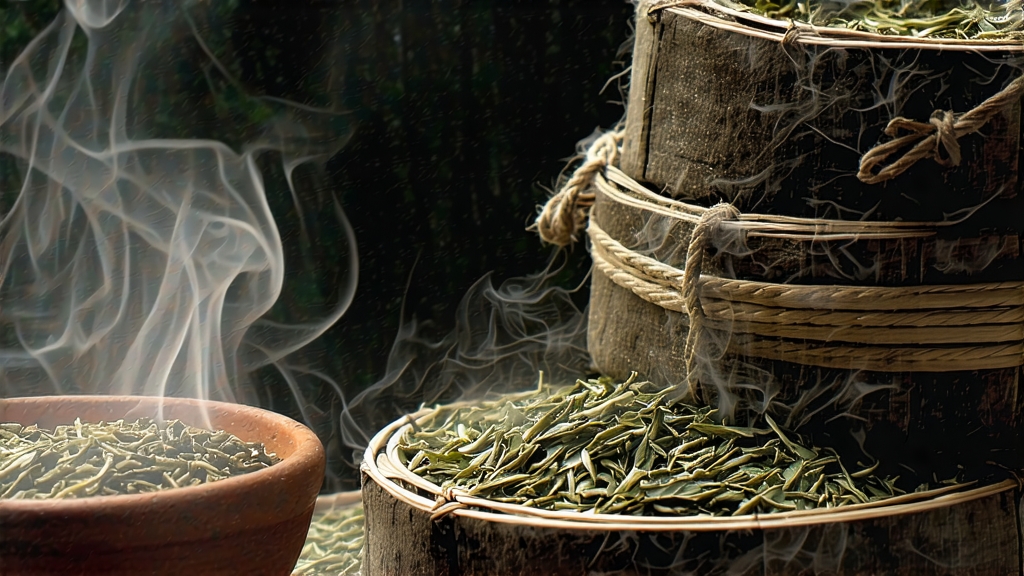
Long before Assam, Ceylon, or Earl Grey entered the English lexicon, there was Lapsang Souchong. International drinkers often meet this tea as a curiosity—its campfire aroma leaping from the cup—yet few realize that every modern black tea traces its lineage back to this rugged leaf born in the Wuyi massif of northern Fujian. To understand Lapsang Souchong is to hold the first chapter of black-tea history in your hands, feel the crackle of pine resin still clinging to the leaf, and taste the mountain mists that once shrouded Qing-era smugglers and Dutch tea clippers alike.
History: From Mountain Hermitage to Global Craving
Legend fixes the birth year at 1646, when Ming loyalist soldiers passed through the village of Tongmu and commandeered fresh tea leaves. To dry the leaf quickly before marching on, farmers spread it over pine fires; the smoke impregnated the cell walls, creating an entirely new flavor category. Whatever the truth, Dutch merchants at the port of Xiamen tasted the result, labeled it “bohea” (a corruption of “Wuyi”), and by 1669 were auctioning it in Amsterdam for more than silver. When Catherine of Braganza brought a chest to London in 1662, the British court succumbed to what Pepys called “a China drink of great smoak and fragrance,” launching two centuries of caravans, clipper races, and ultimately colonial plantations that sought to copy the impossible terroir of Tongmu.
Micro-Terroir: Why Only Tongmu Tastes Like Tongmu
The core zone—lat. 27.7° N, 800–1 500 m elevation—lies inside a national park where granitic cliffs force moist Pacific air upward into perpetual fog. Day-night swings of 15 °C slow photosynthesis, concentrating amino acids, while the humus-rich, slightly acidic soil delivers a minerality likened to wet slate. Crucially, only here does the native pine species Pinus massoniana yield a resin low in turpentine and high in fragrant longifolene; substitute another conifer and the tea becomes harsh. Thus, even within Fujian, authentic Lapsang Souchong is geographically locked to 68 km² of Wuyi core.
Leaf Grades: Souchong, Pekoe, and the Misunderstood “Smoky”
Western packaging often lumps any smoked black tea under “Lapsang,” yet connoisseurs distinguish three grades. Zheng Shan Xiao Zhong (“Original Mountain Small Sort”) uses only spring buds and the first two leaves, smoked for eight hours over young pine embers; the liquor is burgundy-amber, sweetly resinous, with notes of longan and dried lychee. Wai Shan Xiao Zhong (“Outside Mountain”) relies on larger summer leaf from neighboring counties, heavier smoke masking flatter taste. Finally, unsmoked Zheng Shan—called “No-Smoke Souchong”—is dried with gentle warm air, revealing a honeyed maltiness prized in China but rarely exported. Knowing the grade is the first step toward an authentic encounter.
Craft: From Pluck to Perfume
Picking begins at Qingming (early April) when buds still wear their downy cloak. Leaves are withered across bamboo racks suspended in the upper story of two-hundred-year-old wooden houses; below, a slow pine fire exhales through ceiling slats, curling the edges of the leaf while locking in a whisper of smoke. Rolling follows, done by hand on rattan trays until cell sap coats the surface like morning dew. Oxidation—here called “fermentation”—lasts 90–120 min in cedar-lined boxes; the pile is turned every 15 min to ensure even conversion of catechins into theaflavins, the pigments that give black tea its brisk red color. Finally, the leaf is re-fired over a pine ember bed at 80 °C, then allowed to “rest” in linen sacks for thirty days so smoke and tea oils marry. The entire cycle is synchronized with lunar humidity; veteran masters claim they can “hear” when the leaf crackles at 7 % moisture, the sonic cue to cease firing.
Chemistry in the Cup
Gas-chromatography studies identify 32 volatile compounds unique to